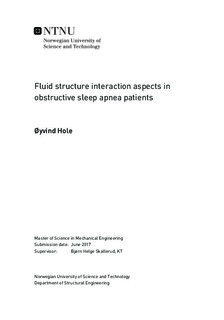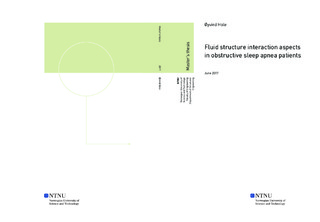| dc.description.abstract | In this master thesis, a comparative study of the feasibility of fluid-structure interaction (FSI) tools has been done in light of simulating the problem of obstructive-sleep apnea (OSA). Part of the study has been done by simulating the benchmark; \textit{Flow Induced Oscillations of a Flexible Beam}, by the different solvers; COMSOL, Abaqus and Abaqus coupled with ANSYS Fluent through third party coupling code MpCCI. By evaluating the results produced a qualifying approach for simulating the case of OSA is done.
By assessing through FSI simulations, insight to the problem at hand can be gained. Making a proper problem formulation can be crucial to get a physical meaningful analysis. When setting up FSI simulations, several choices have to be made to make the most suitable approach. For instance if the type of discretization should be described with a Lagrangian, Eulerian or an Arbitrary Lagrangian-Eulerian (ALE) formulation, and how the coupling of the fluid and solid domain should be done.
The capturing of the interface and the interaction between the fluid and structure proves to be essential for the simulations. In addition to the choice of dicretization and coupling of the domains, the simulations is sometimes limited by technical problems and the feasibility of tools.
The use of computational FSI analysis can be a cumbersome task even if simulations yield decent results. The majority of the benchmark simulations did not produce the results expected. Only two of four simulations reached oscillations resembling the pattern shown in other studies. Thus indicating errors in model description and/or weaknesses of tools. For instance the capability to solve for non-linear behaviour.
The main issue for the benchmark simulations were related to the deformation and mesh motion of the fluid domain by the use of the ALE method, which often required a finer mesh tuning increasing the computational cost. The results from the benchmark were post processed in COMSOL and Abaqus, and compared in order to see to what extent they correlated. For additional perspective a comparable study is referred to in context of some of the findings.
By formulating a simpler problem description for the case of OSA some of the issues related to large deformations were bypassed. The simulation of the soft palate yielded coarse yet useful results, which can be used to get some insights to the disease. However, due to some of the flow specifics other problems were encountered, mainly regarding the embedded 3D simulations done with Abaqus. These primarily concerned convergence criteria for the equilibrium equations, where a low Reynolds number and high flow velocity demanded fine tuning of mesh and additional equilibrium convergence iterations. | |

